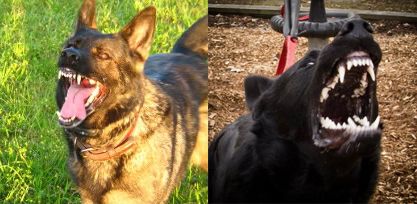Hello:
As this is my first post I'll introduce myself: Andrew May, of Hillview, Newfoundland, Canada, training a Beauceron for her B.H. (trial end of July). I've got the Schutzhund bug and seem to be re-organizing my whole life to do more of it!
I've seen some discussion concerning adding some Malinois blood to the GSD gene pool and thought I'd try to understand how this would be done and what some of the implications might be. I'm aware that this is done to produce F1 pups: most of which I presume are genetic "dead ends" not perpetuated in working lines.
My lack of experience in breeding and training (so far)limits my insight into this stuff and I'm looking forward to reading what those who do the real committed work of producing pups have to say in response.
It is my understanding that the basis for the suggestion is that bringing in Malinois blood could help bring the breed closer to the Van Stephanitz ideal of a more moderately sized, less extremely angulated, agile, fast, courageous animal. I've seen this opinion attributed to Helmut Raiser but have not been able to find any quote or other first hand account from him and cannot confirm this as his opinion. I have no idea if there are others in the working GSD community who might entertain this view.
I wonder also what lines of working GSDs may already have an influence from the dutch and malinois shepherds: Czech? Belgian?
In looking at bringing in outside blood I see some obvious potential benefits (at least in theory) and a bunch of practical difficulties and problems.
Possible (but not always proven) benefits:
-hybrid vigour;
-lowering of inbreed coefficient of descendants allowing for overall lower COI or simply more subsequent line breeding with less negative health side effects;
-greater genetic variation to effect change to over-angulated rear end: seems very difficult to select away from this in GSD gene pool now (theory described in the Coppinger's book "Dogs": in fact, Coppinger argues that sled dogs keep improving because there is so much genetic material to work from, as sled dogs constantly infused with blood from outside crosses);
-better mothering: Scott and Fuller study showed F1 mothers were better than purebred mothers at care of pups and milk production;
-healthier puppies: Scott and Fuller study shows F1 puppies very healthy;
-maybe better nerves: sled dog breeders such as Egil Ellis (World Sprint Champion), and Mitch Seavey (2004 Iditarod champ with a team of outcrossed 3 year olds) report outcrosses result in more stable confident dogs, "goldadors" have very low failure rate in guide dog programs;
-maybe some of malinois drive into GSDs.
practical difficulties and possible problems:
-probable reduction in consistency of pups at F1, F2 and following;
-loss of certain desirable "hard wired" capabilities: ie genetic grip: need to "re-select" even more than usual;
-re-integration of subsequent generations of pups into GSD population: how to determine what is a GSD, by fraction (ie 7/8, or 15/16?), by jury, by standard, by fiat?
-notwithstanding averaging tendency of an outcross (Scott and Fuller) especially at F1 generation, greater unpredictability of outcomes of conformation and temperament;
-the desirability of these crosses being undertaken by the very best and most prolific breeders, who have reputations to maintain for production of consistent cutting edge pups. How to avoid a situation where this type of breeding is done with marginal dams and sires by breeders with limited experience, or, in at least one fairly successful litter of GSD*Mal PSDs I was told of by the owner of the dam, by accident.
-how to maintain the superlative GSD qualities.
-possible reduction of "extreme" working attributes on outcross, even if both sire and dam are themselves extreme: here I think critical working drives.
-all the impenetrable politics of dogs.
Respectfully trying to follow an idea through to a logical conclusion.
rgds, Andrew May
 Previous Topic
Previous Topic Index
Index Next Topic
Next Topic












 Top
Top

.jpg)

